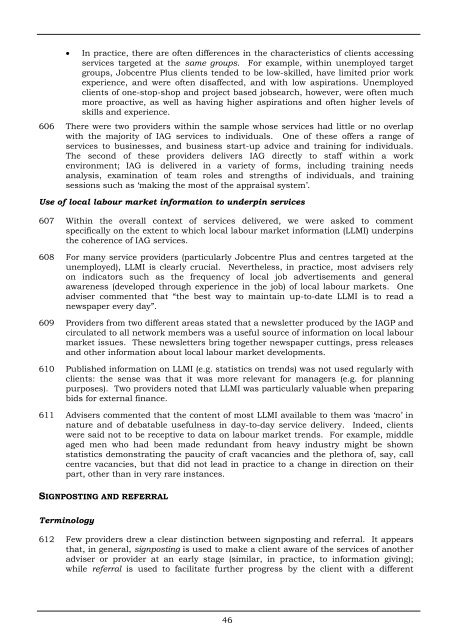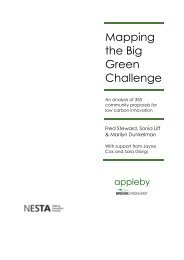Client needs for coherent information, advice and guidance services ...
Client needs for coherent information, advice and guidance services ...
Client needs for coherent information, advice and guidance services ...
You also want an ePaper? Increase the reach of your titles
YUMPU automatically turns print PDFs into web optimized ePapers that Google loves.
• In practice, there are often differences in the characteristics of clients accessing<br />
<strong>services</strong> targeted at the same groups. For example, within unemployed target<br />
groups, Jobcentre Plus clients tended to be low-skilled, have limited prior work<br />
experience, <strong>and</strong> were often disaffected, <strong>and</strong> with low aspirations. Unemployed<br />
clients of one-stop-shop <strong>and</strong> project based jobsearch, however, were often much<br />
more proactive, as well as having higher aspirations <strong>and</strong> often higher levels of<br />
skills <strong>and</strong> experience.<br />
606 There were two providers within the sample whose <strong>services</strong> had little or no overlap<br />
with the majority of IAG <strong>services</strong> to individuals. One of these offers a range of<br />
<strong>services</strong> to businesses, <strong>and</strong> business start-up <strong>advice</strong> <strong>and</strong> training <strong>for</strong> individuals.<br />
The second of these providers delivers IAG directly to staff within a work<br />
environment; IAG is delivered in a variety of <strong>for</strong>ms, including training <strong>needs</strong><br />
analysis, examination of team roles <strong>and</strong> strengths of individuals, <strong>and</strong> training<br />
sessions such as ‘making the most of the appraisal system’.<br />
Use of local labour market in<strong>for</strong>mation to underpin <strong>services</strong><br />
607 Within the overall context of <strong>services</strong> delivered, we were asked to comment<br />
specifically on the extent to which local labour market in<strong>for</strong>mation (LLMI) underpins<br />
the coherence of IAG <strong>services</strong>.<br />
608 For many service providers (particularly Jobcentre Plus <strong>and</strong> centres targeted at the<br />
unemployed), LLMI is clearly crucial. Nevertheless, in practice, most advisers rely<br />
on indicators such as the frequency of local job advertisements <strong>and</strong> general<br />
awareness (developed through experience in the job) of local labour markets. One<br />
adviser commented that “the best way to maintain up-to-date LLMI is to read a<br />
newspaper every day”.<br />
609 Providers from two different areas stated that a newsletter produced by the IAGP <strong>and</strong><br />
circulated to all network members was a useful source of in<strong>for</strong>mation on local labour<br />
market issues. These newsletters bring together newspaper cuttings, press releases<br />
<strong>and</strong> other in<strong>for</strong>mation about local labour market developments.<br />
610 Published in<strong>for</strong>mation on LLMI (e.g. statistics on trends) was not used regularly with<br />
clients: the sense was that it was more relevant <strong>for</strong> managers (e.g. <strong>for</strong> planning<br />
purposes). Two providers noted that LLMI was particularly valuable when preparing<br />
bids <strong>for</strong> external finance.<br />
611 Advisers commented that the content of most LLMI available to them was ‘macro’ in<br />
nature <strong>and</strong> of debatable usefulness in day-to-day service delivery. Indeed, clients<br />
were said not to be receptive to data on labour market trends. For example, middle<br />
aged men who had been made redundant from heavy industry might be shown<br />
statistics demonstrating the paucity of craft vacancies <strong>and</strong> the plethora of, say, call<br />
centre vacancies, but that did not lead in practice to a change in direction on their<br />
part, other than in very rare instances.<br />
SIGNPOSTING AND REFERRAL<br />
Terminology<br />
612 Few providers drew a clear distinction between signposting <strong>and</strong> referral. It appears<br />
that, in general, signposting is used to make a client aware of the <strong>services</strong> of another<br />
adviser or provider at an early stage (similar, in practice, to in<strong>for</strong>mation giving);<br />
while referral is used to facilitate further progress by the client with a different<br />
46











